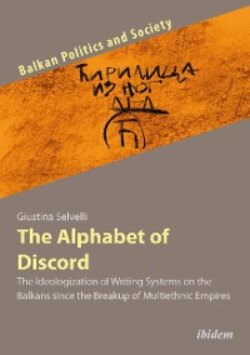Оглавление
Giustina Selvelli. The Alphabet of Discord
PREFACE
ILLUSTRATIONS
1. INTRODUCTION. 1.1 The Balkan space between problems of multiplicity and claims of homogeneity
1.2 The role of writing and of the “Other” in the national discourse
1.3 Methodological considerations: sources and approaches
1.4 Semiotic and relational aspects of alphabets and nationalism
2. THE RECEPTION OF THE ABECEDAR PRIMER (1925) IN BULGARIA. 2.1 Issues related to the adoption of new writing systems
2.2 Post-imperial national identity dynamics
2.3 The situation in Aegean Macedonia after World War I
2.4 The publication of the Abecedar (1925)
2.5 Some peculiarities related to the characters of the Abecedar
2.6 The “involvement” of Cyril and Methodius
2.7 Conclusions: the fate of the Abecedar after 1925
3. THE “LATINIZATION” IDEOLOGY AND THE BULGARIAN DEBATES. 3.1 Introduction: issues of script change
3.2 The Latinization ideology in the Soviet Union
3.3 The Latin alphabet as a “modernizing” tool in the Balkans
3.4 The positions in support of Latinization in Bulgaria
3.5 The positions in defense of Cyrillic: contextual and internal factors
3.6 Defensive and symbolic motivations rejecting Latinization
3.7 Technical imperfections of the Latin alphabet
3.8 Conclusions: the national character of the alphabet
4. THE CONTRAST BETWEEN ARABIC AND LATIN SCRIPTS AMONG THE BULGARIAN TURKS. 4.1 The impact of the Eurasian alphabet reforms on Turkey
4.2 The ambivalent status of the Latin alphabet in Bulgaria
4.3 Language and script restrictions for the Turks of Bulgaria
4.4 Conclusions: the disruption of writing practices
5. SERBO-CROATIAN IN TWO SCRIPTS: DIGRAPHIA, “ALPHABET SYNTHESIS” AND BILITERACY. 5.1 Linguistic and historical introduction
5.2 Post-war alphabet ideologies: four parallel trends
5.3 The influence of the “pro-Latinization” factors
5.4 The first proposals of “alphabet synthesis” appearing in Život i rad
5.5 The “Yugoslav alphabet” by Pavle Ž. Radivojević
5.6 Reactions to the “mixed alphabet” proposals
5.7 Živaljević’s rejection of the Yugoslav alphabet and Trivunac’s defense of Cyrillic
5.8 Conclusions: the developments of the alphabet question in Yugoslavia
6. CYRILLIC AT WAR: SCRIPT IDEOLOGIES IN THE INDEPENDENT STATE OF CROATIA, 1941-1945. 6.1 From unitarian ideologies to assertions of difference in the language field
6.2 The development of the language situation before the NDH
6.3 “Cyrillicide” in the Independent State of Croatia
6.4 Writing ideologies between purism and denialism
6.5 The “Orientality” of the Serbs and the role of the Glagolitic alphabet
7. THE REDISCOVERY OF GLAGOLITIC: FROM REGIONAL TO NATIONAL PHENOMENON. 7.1 The new signification context of the Glagolitic alphabet
7.2 The alphabet issue during the period of socialist Yugoslavia
7.3 The creation of the Aleja Glagoljaša in Istria and the role of Zvane Črnja
7.4 The rebellious and democratic character of Glagolitic
7.5 The universal value of regional Istrian culture
7.6 The Glagolitic as a marker of continuity and prestige after the end of Yugoslavia
7.7 The institutionalization of the Glagolitic alphabet by the Croatian state
7.8 Glagolitic as a national symbol in an “exclusivist” sense
8. THE MODIFIED STATUS OF CYRILLIC IN POST-SOCIALIST CROATIA AND SERBIA. 8.1 Introduction: Issues of biscriptality
8.2 The first changes in the status of the Cyrillic alphabet
8.3 The Serbian case: will bialphabetism survive?
8.4 The destruction of allographic traditions
8.5 Croatian reactions to the bialphabetic plaques in Vukovar
8.6 The Serb minority in Croatia as the “Other”
8.7 The relevance of the public writing context
8.8 The multigraphic character of the Croatian writing tradition
8.9 Conclusions: patterns of symmetrical differentiation
9. BULGARIAN CYRILLIC BETWEEN TRADITION AND MODERNITY: THE “KRONSTEINER AFFAIR” 9.1 Introduction: the post-socialist ideological context in Bulgaria
9.2 The first debates on writing issues in the late 1990s
9.3 The origins of the “Kronsteiner affair”
9.4 Bulgarian Cyrillic between “Europhilia” and “Russophilia”
9.5 The issue of alphabetic coexistence in the European context of pluralism
9.6 Cyrillic as a “communist” alphabet
9.7 Bulgarian institutions against Kronsteiner
9.8 Further reactions in the periodical and scientific press
9.9 Moderate positions on opening to the Latin alphabet
9.10 Conclusions: open issues of transliteration
10. THE POPULAR DIMENSION OF THE CYRILLIC ALPHABET AND THE REDISCOVERY OF GLAGOLITIC. 10.1 The “Kronsteiner effect”
10.2 Cyrillic and modern technologies
10.3 The link between Cyrillic and capitalism and the Bulgarian typefaces
10.4 The popularization of Cyrillic and the May 24 celebration
10.5 Conclusions: the revitalization of Glagolitic and “ethnogenetic” questions
11. FINAL NOTES. 11.1 The relevance of the post-imperial and post-socialist factors
11.2 The symbolic dimension of the alphabet in the Balkans
12. LIST OF REFERENCES. Primary Sources
Official Legislative Sources
Secondary Sources
